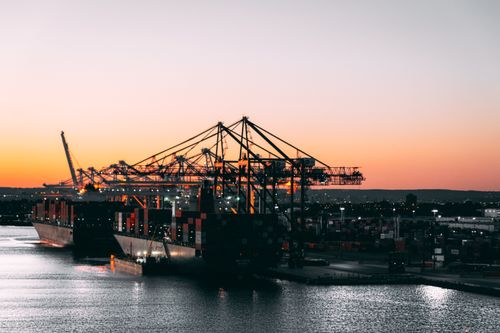By Amelia Zimmerman
While supply chains are typically evaluated for quality, cost, speed, and reliability, ESG risks require a new class of evaluations that go beyond Scope 3 emissions.
Faced with post-pandemic supply chain issues, organizations are widening the vendor pool. At the same time, companies face mounting pressure from boards, investors, consumers, and employees to report on ESG. The double threat of increasingly complex supply chains and rigorous ESG expectations is a serious challenge for organizations.
But an ESG strategy that ignores the supply chain or pays it minimum heed is incomplete. The scale and impact of supply chains can dwarf that of a company’s direct operations. While measuring and managing ESG across multiple vendors is difficult, it can also be a source of enormous opportunity.
Joshua Mellinger, head of corporate sustainability at Scoular, believes supply chains are a key part of a brand’s ESG efforts. “Supply chains offer the greatest source of influence for a brand to create change at scale,” he says.
Supply Chain Risks
Supply chains are typically evaluated for quality, cost, speed, and reliability. However, ESG risks require a new class of evaluations, from sustainability factors like pollution, waste, and use of raw materials; to social considerations like human rights, labor conditions, and employee health and safety; and governance concerns like non-compliance, corruption, and bribery.
It’s no longer an option for companies to turn a blind eye to vendor shortcomings. As more labor scandals and human rights violations receive media attention, public-facing brands are being held responsible for the actions of their suppliers and facing the brand backlash that comes with it.
Even from a brand equity perspective, requiring high ESG standards for vendors is necessary. “ESG issues occurring at supply chain partners can impact brand value, shape consumer perceptions, and lead to increased regulatory challenges,” Mellinger says.
Enrique Alvarez, managing director at Vector Global Logistics, agrees. “I hope that companies are evaluating their supply chains for the right reasons — because it’s the right thing to do — but regardless, they risk a public PR crisis and stakeholder fallout if they fail to consider this aspect of their operations,” he says.
Alvarez offers the example of a company that donates a portion of sales to homelessness but is later discovered to have modern-day slavery in its supply chain. “At this point, they risk their reputation, which can have a significant financial impact: investors pull out, employees leave, customers are no longer loyal. These effects can be devastating, and the business may or may not recover,” he explains.
But there is more than brand image at stake. Let’s look at the “S” ESG. Social factors can be difficult to quantify and are often overlooked, but ignoring them can pose serious risks to operations. S&P Global warns companies of the risks of ignoring social factors: poorly managed working conditions run the risk of strikes and protests, unsafe products pose problems on multiple levels, and changing public sentiment and demographics can close markets almost overnight.
Unaddressed environmental, social and governance risks can lead to supply chain disruption, compromised inventory, delayed schedules, unforeseen legal costs, uprising among workers, a decrease in sales, and a lack of interest from investors and talent. While an organization’s direct risks might be limited in scope, supply chains open up entirely new risk categories.
An Issue of Measurement
The reason many companies leave suppliers out of their ESG efforts is clear: measuring and managing ESG across global supply chains is exceptionally difficult.
“Despite technological advancements, logistics and supply chain still remain a very complex, manual, and relationship-driven process,” Alvarez says. Larger companies tend to have more complex supply chains, making measurement and evaluation difficult.
“Supply chains are dynamic,” Mellinger adds. “Even a single material or ingredient could come from multiple source locations, change hands, and be transformed before a company ever receives an item. Creating standardized measurements and data flows are challenging, especially as raw material providers may not have any insight into the ultimate end consumer.”
Take the “G” in ESG as an example. Concerns around governance include factors such as company structure, policies, and compliance. But with so many different regulatory frameworks and standards at play in global trade, as well as cultural differences and a lack of data transparency, it can be challenging to establish universal standards for supply chain partners.
Supply Chain Opportunities
It’s not all bad news. Organizations that embrace supply chain ESG can make a serious impact internally and within their industries.
As far as the “E” of ESG is concerned, supply chains are crucial to reducing environmental impact and achieving carbon neutrality. And for some companies, scope 3 reporting presents untapped opportunities when it comes to supply chain management. According to MSCI, only 18% of MSCI ACWI IMI reported scope 3 emissions as of March 2020. But scope 3 can account for 90 percent or more of a business’s emissions. Only when it starts to quantify supply chain sustainability can a company calculate its true environmental impact — and then work to change it.
Getting Started with Supply Chain Management
Measuring and managing ESG across the supply chain requires access to appropriate data, a flexible technology partner, and accountability for all suppliers.
Data
Data transparency across the supply chain is critical. “Supply chains require more diligence and can be a major blind spot for companies that lack transparency,” Mellinger says. Organizations need access to comprehensive, real-time data for accurate reporting and insights into vendor operations.
Vendor Selection and Approvals
The best way to ensure ESG standards are implemented across the supply chain is to hold all vendors to universal standards through supplier contracts. Contract renewals with existing vendors offer an opportunity to update ESG standards, but seeking new vendors can be the simplest way to improve metrics, as potential suppliers can be filtered based on existing ESG performance. Incentive structures can also be effective in improving supplier ESG scores.
Technology and Automation
Finding the right technology partner is crucial to supply chain success. ESG software should allow for integration with supplier data and tools, and offer data visibility through custom dashboards, automated reporting, and target management that goes beyond just carbon accounting to embrace the, E, S, and G of ESG management
Drive Change All Around
Upholding ESG standards throughout global supply chains is a unique challenge, but one that is necessary for ESG to make a significant impact in the private sector. When organizations hold vendors to high environmental, social and governance standards, entire industries can transform more holistically. The opportunity is there for organizations to become market leaders in ESG, setting the standard for their industries and inspiring change at scale.
“Companies that work collaboratively with supply chain partners drive significant operational improvements and generate share value that is three times higher than companies only focused on their own operations,” Mellinger says.
Why Equilibrium?
As your ESG goals and plans evolve, it’s vital to stay on top of risks and opportunities in your supply chain. Future-proof your organization’s ESG reporting with Equilibrium, a next-gen, end-to-end ESG management solution that helps companies move past static spreadsheets and legacy solutions.
Learn more about how Equilibrium and FiscalNote’s suite of solutions can help you stay ahead of ESG disclosure, sustainability reporting, and climate risk management across your entire value chain.
Take charge of your impact on people and the planet
Create, control, and communicate your ESG360TM story through Equilibrium, a holistic, sustainability data management solution combining cutting-edge AI technology, insights, and strategic advisory to drive decisions.






